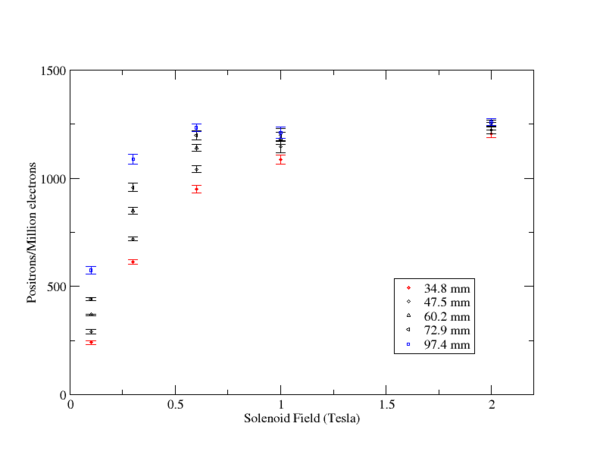Niowave 1-2016
Niowave Positron Project Progress for January 2016
The positron collection efficiency was investigated for several solenoidal magnetic field strengths and beam pipe radii to determine the impact of using a solenoidal field strength that was less than one Tesla. The figure below shows the number of positrons that exit the solenoid for every million electrons that impinge a 2mm thick PbBi target sandwiched between 0.25 mm thick stainless steel windows. If the solenoids field strength was limited to a maximum of 0.3 Tesla, then a 97.5 mm diameter beam pipe would have the same positron transport efficiency as a 1.0 Tesla field and a 34.8mm diameter beam pipe. Otherwise, the positron transport efficiency can increase by a factor of two when using a 34.8 mm diameter beam pipe if the solenoidal field strength is increased from 0.3 Tesla to 1.0 Tesla.

|
Question: Will a thicker downstream exit window increase the positron production efficiency by providing more material for a brehm photon to pair produce in?
Positrons were counted exiting a ideal 0.2 Tesla solenoid that was 15 cm long. A ten MeV electron beam with a 0.5 cm cylindrical radius impinged a 2mm thick PbBi liquid target that had a surface area of 2.54 cm x 2.54 cm. A 0.25 mm thick stainless steel entrance window was used.
Target is at -106 mm, entrance SS window is at -108.25 mm , exit SS window is at -103.75 mm, A sensitive detector for positron is placed at Z= +44mm. The sensitive detector is a cylinder of radius 11.74 cm.
| SS Exit WIndow Thickness (mm) | Positrons/Million electrons |
| 0.0 | 1142,1096,1149,1073,1083 = 1109 +/- 35 |
| 0.25 | 774,836,800,785,798 = 798 +/- 23 |
| 0.5 | 693,704,713,697,715 = 704 +/- 10 |
| 1.0 | 587,606,548,592,550 =577 +/- 26 |
- Conclusion 1
- Positron production efficiency improves when the exit window is made thinner
- Conclusion 2
- You loose about 28 +/- 4 % of the positrons in the 0.25 mm thick SS exit window.